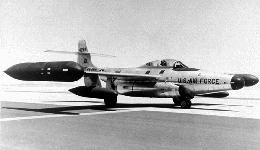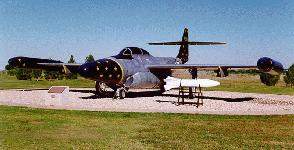







The F-89 was a twin-engine, all-weather fighter-interceptor designed to locate, intercept, and destroy enemy aircraft by day or night under all types of weather conditions. One of the most heavily armed fighter aircraft, the F-89 was the backbone of the North American Air Defense Command for more than 17 years. The F-89 helped the Air Defense Command to patrol the skies during the period when Soviet intercontinental bombers first became a threat. The first F-89 made its initial flight in August 1948 and deliveries to the Air Force began in July 1950. Northrop produced 1,050 F-89s.
The F-89 was the first multi-seat, all-weather jet interceptor. It was the first aircraft designed to carry an all-rocket armament and the first to carry the Hughes Falcon air-to-air guided missile. It carried a pilot in the forward cockpit and a radar operator in the rear who guided the pilot into proper attack position. Northrop was awarded a contract May 3, 1946, to build two prototypes designated XP-89. The XP-89 rolled out of its California plant in the summer of 1948. After a number of taxiing and brake tests were performed, the XP-89 was moved to the high desert north of Los Angeles known as Muroc Dry Lake (later Edwards AFB). It was at this time it was re-designated as F-89, classifying it as a fighter. The air and ground crews at Muroc remarked that it looked like a scorpion ready to strike. The name stuck and was later officially recognized by the Air Force.
The F-89 made its maiden flight Aug. 16, 1948, with the first production model being accepted Sept. 28, 1950. At the time of its production, the F-89 had an advanced radar system enabling the crew to track and engage hostile bombers in any weather.
On July 19, 1957, a Genie test rocket was fired from an F-89J, the first time in history that an air-to-air rocket with a nuclear warhead was launched and detonated. Three hundred and fifty F-89Ds were converted to "J" models which became the Air Defense Command's first fighter-interceptor to carry nuclear armament.
Specifications | |
| Wing Span | 60 feet |
| Length | 53 feet, 10 inches |
| Height | 17 feet, 6 inches |
| Weight | 47,719 lbs. maximum |
| Armament | Two AIR-2A Genie air-to-air rockets with nuclear warheads plus four AIM-4C Falcon missiles |
| Engines | Two Allison J35 engines with 8,000 lbs. of thrust each; with afterburner |
| Cost | $1,009,000 |
| Maximum speed | 630 mph |
| Cruising speed | 465 mph |
| Range | 1,000 miles |
| Service Ceiling | 45,000 feet |



